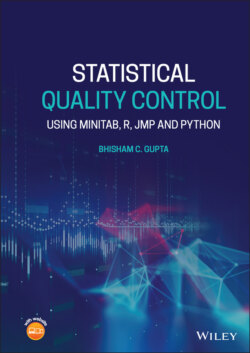Читать книгу Statistical Quality Control - Bhisham C. Gupta - Страница 55
2.4.2.3 The 5S Method
ОглавлениеThe tool known as 5S is defined as a physical methodology that leads to a workplace that is clean, uncluttered, safe, and well organized, resulting in reduced waste and increased productivity. The tool helps create a quality work environment, both physical and mentally.
The 5S philosophy applies in any work area suited for visual control and Lean production. 5S is derived from the following Japanese terms that refer to creating such a workplace:
Seiri: To separate needed tools, parts, and instructions from unneeded material and to remove the unneeded ones.
Seiton: To neatly arrange and identify parts and tools for ease of use.
Seiso: To conduct a cleanup campaign.
Seiketsu: To conduct seiri, seiton, and seiso daily to maintain a workplace in perfect condition.
Shitsuke: To form the habit of always following the first four S’s.
Table 2.3 lists the Japanese terms and the English translations of the 5S methods.
Benefits to be derived from implementing a 5S program include:
Improved safety
Higher equipment availability
Lower defect rates
Reduced costs
Increase production agility and flexibilityTable 2.3 The 5S methods.JapaneseTranslatedEnglishDefinitionSeiriOrganizeSortEliminate whatever is not needed by separating needed tools, parts, and instructions from unneeded material.SeitonOrderlinessSet in orderOrganize whatever remains by neatly arranging and identifying parts and tools for ease of use.SeisoCleanlinessShineClean the work area by conducting a cleanup campaignSeiketsuStandardizeStandardizeSchedule regular cleaning and maintenance by conducting seiri, seiton, and seiso daily.ShitsukeDisciplineSustainMake 5S a way of life by forming the habit of always following the first four S’s.
Improved employee morale
Better asset utilization
Enhanced enterprise image to customers, suppliers, employees, and management
